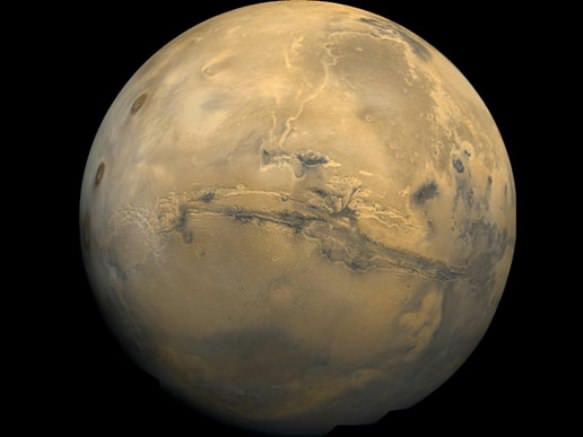[/caption]
“What type of planet is Mars?” is a question that many readers ask. Mars is one of the four terrestrial planets. Mercury, Venus, and Earth are the other three. All of the terrestrial planets are made up of rock and metals. The remaining planets are classified as the outer gas giants.
All of the terrestrial planets have the same basic structure: core, mantle, crust; although each layer differs in thickness depending on the planet. Mercury has an average density of 5.43 g/cm3. Earth is the only planet more dense than Mercury. Mercury most likely has a liquid core that is mostly an iron-nickel alloy. The core accounts for as much as three-fourths of the planet’s radius. There are no numbers available for how thick the mantle and core are. Venus has a crust that extends 10-30 km below the surface. After that, the mantle reaches to a depth of some 3,000 km. The planetary core is a liquid iron-nickel alloy. Average planet density is 5.240 g/cm3.
Even though we live on Earth, not everyone is aware of its density and the depth of the various layers of our home world. The crust thickness averages 30 km for land masses and 5 kilometers for seabeds. The mantle extends on to an additional depth of 2,900 km. The core begins at a depth of around 5,100 km and is in two distinct parts: the outer core of liquid iron-nickel alloy and the inner core which is a solid alloy of iron-nickel. Average planet density is 5.520 g/cm3. The final terrestrial planet is Mars. Mars is roughly one-half the diameter of Earth, which leads scientists to speculate that the core has cooled and solidified. The depth of the crust and mantle are not known for sure, but the average planet density is 3.930 g/cm3. While there are only four terrestrial planets in our Solar System, here is a report on how NASA is trying to find more in other star systems.
Since we are talking specifically about Mars, we will talk about the composition of the planet’s surface material. There are hundreds of volcanoes on the surface of Mars. Several are regarded as the tallest mountains in the Solar System. Without plate tectonics, these volcanoes erupted for millions of years. Those massive eruptions explain why the entire surface is covered in basalt that is high in iron content. The iron content in the basalt has interacted with the Martian atmosphere and oxidized. The iron oxide explains why the entire Martian surface is coated in a reddish dust.
Answering ”what type of planet is Mars” took us on a little bit of a tangent. Hopefully, it is a tangent that will inspire you to find out more about the Red Planet.
We have written many articles about Mars for Universe Today. Here’s an article about the gravity on Mars, and here’s an article about the size of Mars.
If you’d like more info on Mars, check out Hubblesite’s News Releases about Mars, and here’s a link to the NASA Mars Exploration home page.
We’ve also recorded an episode of Astronomy Cast all about Mars. Listen here, Episode 52: Mars.
Source:
NASA

